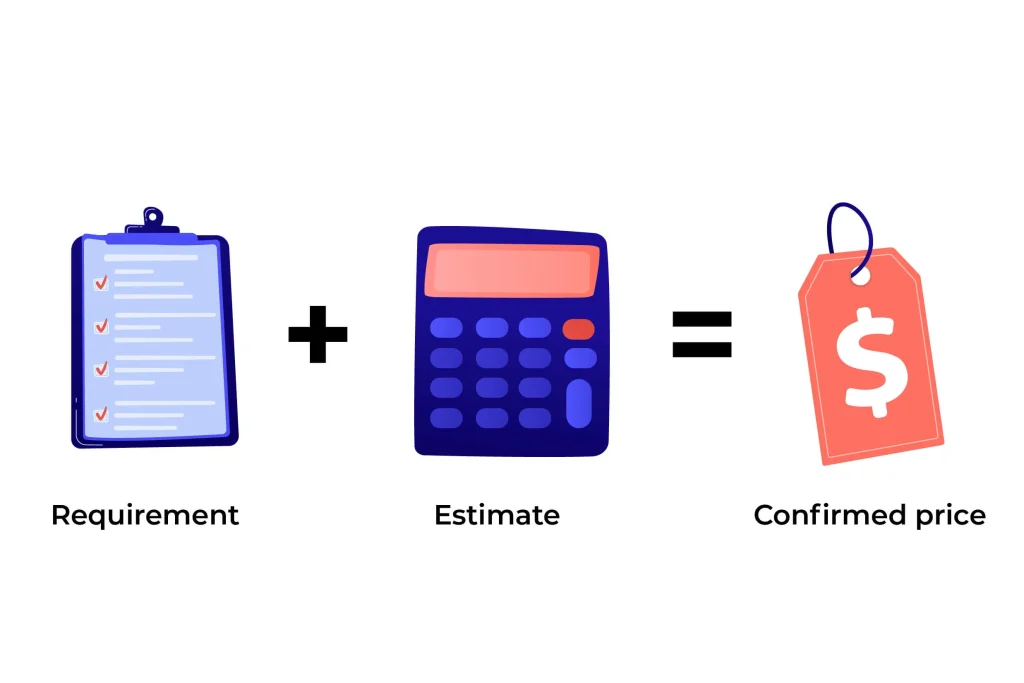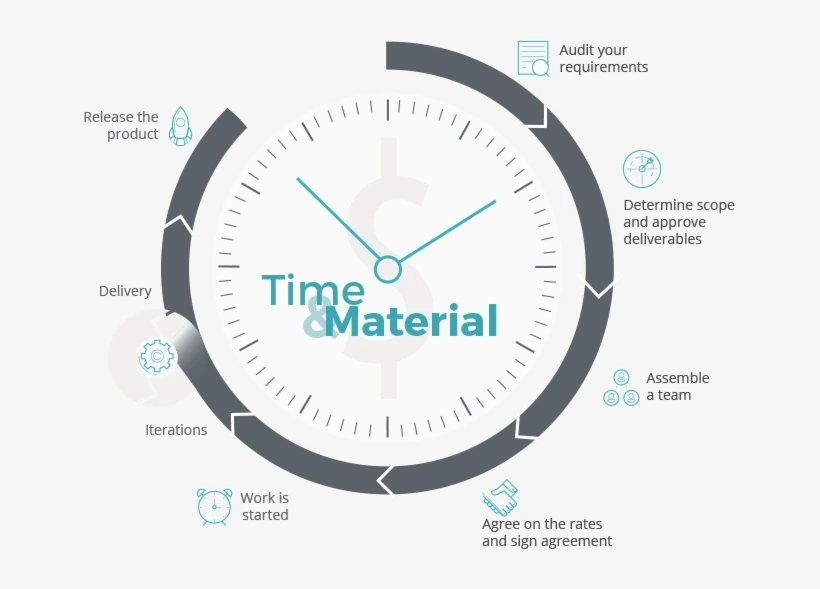What is a fixed price contract?
With fixed price payment terms, you will pay for everything right after signing the contract. The amount of money will be identified through discussions between the two parties.
This is the most common model as it ensures that you don’t spend additional costs in the future. Most businesses plan for financial allocation beforehand. It’s understandable if a fixed price made them feel secure.
Because of this, project scope and requirements will be fixed too. Any changes, even the slightest, will affect the total price. The contract outlines what your vendor will do during the development and the expected results.
How it works
I believe that the fixed bid cooperation model is the simplest and safest to follow.

Initially, you and the vendor agree on a certain rate for the entire project. To do so, you must first create a plan and thoroughly document the scope of the work. The development team gets to work after you make a down payment for them and set a due date.
Every change necessitates a renegotiation of the agreement. You can see your ready product when it’s done and make adjustments at that time.
For this, we have 2 types of fixed price:
- Firm-fixed-price contract: the price is not subject to any changes.
- Cost-plus-fixed-fee-contract: documentation of additional payment if any changes happen during the development and after the negotiation and fixed contract is signed.
Pros of fixed price
- The budget is set in stone. A fixed-price contract allows you to set aside a specific amount of time and money required to complete a task.
- Only minimal project management is required. You do not need to spend time on project management because everything is defined in a contract. You wait until the project is completed and check if the results follow your requirements and specifications.
- Before beginning the project, you must conduct a market analysis and forecast what will work best for your users and business. The contract must be specified in detail, and developers must be fully aware of the scope of the work.
Cons of fixed price
- There is no guarantee that you will not go over budget.
- Limited in consulting with hired developers. When you plan every step ahead, you miss out on the chance to consult with the tech team during the development process.
- There is less control and flexibility. A fixed-price contract may appear to give you more control, but it actually does the opposite. The development team will deliver what is specified in the project scope, so you will not have the opportunity to change plans or provide feedback after each iteration.
- One risk is associated with a product’s quality and ability to meet your needs.
What is time and material (T&M) contract?
With this contract, you will pay the vendor based on the number of developers, the technical infrastructure needed, and work hours. Hence the name Time & Materials (T&M).
T&M would free you from giving rigid deadlines but bring concerns about unknown estimated prices during the project time. You can add in or out any adjustments you want anywhere, anytime. Your final payment will be counted based on the working hours that the team did and the materials costs during the process. As a result, the time limit for the project is up to you.
How it works
Time and Material (T&M) model differs significantly from the Fixed-Price model. Rather than paying a lump sum upfront, you pay the software team for the work hours to complete a given project and the materials used.
First, you identify an overview of the project scope. Second, you can jump on the development immediately and make changes during the process. Most T&Ms follow agile development, so you can ask for monthly deliverables or weekly meetings for updates.

This type of collaboration model is useful when you can’t predict how much the project will cost or how long it will take to complete, as there is no set price or rigid deadlines for the team. Because of this, many vendors will ask for a deposit first. You can pay for the rest per month or after the project is done.
Pros of T&M
- Ability to control your project progress and deliverables. You can make adjustments during development time without limitation.
- You can scale the team up or down along with your current resources.
- Constant contact with the vendor’s team ensures the final project’s outcome because you can assess their working process and give feedback.
- Starting time is right away after you have your idea in mind. You can come up with further details during the building process.
Cons of T&M
- If you make many changes, it can lead to cost overrun. Thus, T&M requires a higher level of budget management and allocation.
- Just because you can change here and there doesn’t mean you should anytime an idea comes up.
- Being reliant too much on the development team will not guarantee the quality of the outcome. It would be best if you spent time bringing more details about your project’s dream.
- Risk of a bad vendor. In some cases, many think of T&M as a scam. Since you pay for the hours and number of developers, can you make sure they are not trying to stretch the development time for more money? Of course, not all IT outsourcing does this, but many can.
The differences between fixed price vs time and materials
If you have any confusions, we are providing the key factors that show the difference between time and material contract and fixed price.
| Compared aspects | Fixed Price | Time and Material |
|---|---|---|
| Scope & requirements | They are frozen at the early stage and further estimates will be made along those. Because of this, you must spend lots of time identifying them before going into discussion with a vendor and development afterwards. | You must define the general scope before starting the project or contacting a vendor. The detail can be update and change through development |
| Resource estimation | Number of developer and development timeline are agreed before signing the contract and starting the development | Since your project scope can change, resource estimation will be performed through each stage of development. You can extend or shrink your team as needed However, we recommend not making too many changes and keeping your core developers close. |
| Payment | It is estimated once when assigning the contract. | They estimate the cost based on the team’s efforts and resources in usage. For this, you will be asked to put down a deposit before development then pay the rest per month or after the result is delivered, based on the agreement between the two parties. |
| Change management | Any adjustments cannot be accepted when we use a fixed price because it is not included in the signed package. If you are determined to change, you have to pay more for that. | Freely to accommodate your changing request. Adding a new feature? It won’t be a problem. |
| Timelines | It must be predefined in the contract for the parties involved. Because of this, minimal project requirements are required, which means you don’t have to follow them 24/7 since everything is locked in. As long as they deliver the project on time, you don’t need to worry about how much time they spent to develop. | This would be varied by the way you want to. This gives you more freedom and flexibility in project management. You will have to work closely with your vendor’s team to make sure everything is on the right track. For this, weekly or monthly deliverable is preferred with T&M. |
| Development model | Standard waterfall development. However, some development companies are open for monthly deliverables that give you update on the process. | Flexible to switch to standard or agile development when needed |
When to choose what?
Do not hesitate to try on Time and Material contract if:
- Your project is complex and lengthy.
- You only have a general idea of the project but have yet to come up with further details.
- You want an open space for discussion and consultation during development with technical experts.
- You want flexible control since the requirements are likely to change.
- You know exactly who you want to work with, so the project can begin soon. This can work wonderfully with your long-term software development partner, where there is trust.
T&M works well in product development and startups (mainly due to the lower price and the scope constantly changing). Also, for projects like maintenance, DevOps, or IT Support Outsourcing, you can use T&M, as there is no need to hire a full team 24/7. These projects require a few hours to finish, so T&M is much more cost-effective.

Choose a Fixed bid if:
- It is a small or medium-sized project.
- You have clearly defined your needs and expectations for the developers.
- The project specifications will not change.
- This payment contract is ideal if you are looking for the best price.
To sum up, fixed price is the top solution for fully defined or budget-based projects. Surprisingly, most enterprises Synodus works within digital transformation and custom software development prefer this payment contract. It gives them more control over finance, and they already know what needs to be done.
Unfortunately, you can’t identify a scam solely based on payment methods. While the success of T&M lies in project management, the success of fixed prices relies on how detailed your project scope is. Therefore, it’s also based on your effort.
When choosing a vendor, you should look for referrals, review sites and read their portfolio carefully to analyze their experiences. Don’t rush. Take your time. There are plenty of software development companies.
The best of both worlds: Using T&M with a fixed cap
Both T&M and fixed prices model have their prime and downfall. There isn’t a perfect solution. Keep in mind that both can lead to cost overrun and bad results if you have bad project management and an unclear plan.
Synodus recommend that it should be defined by the project’s complexity (50%) and how detailed your project scope/ priority is (50%)
But if you haven’t made up your mind, we have 2 solutions for you:
- Let’s talk with our experts. Share your thoughts, and we will consult what is best for you.
- Leverage the best of both: flexible payment with T&M but a fixed cap to ensure your projects won’t pass that limit. This is also called the capped time and materials. You still pay for the hours of work and number of developers; you can still make changes here and there. We will guarantee everything is under your budget and give you a heads-up for any crossover.
At Synodus, we focus on strategic custom development solutions for you. The one that works for this company might not be it for others. To prevent technical debt and failed projects, we provide in-depth consultation with no fog of tech before any final decisions.
It’s much better to partner with a software development company that offers flexible payment models. This helps you balance between technical and finance while allowing you to focus on more demanding and growth-focused decisions.
For Custom Software Development, Synodus utilizes extensive tech stacks, covering everything from the web, mobile, cloud to on-premises development. Aiming to become your strategic tech partner, we guide you through every stage of agile development, from requirements analysis, solution architecture to testing and long-term maintenance.
View our portfolio and Talk with our team today!
Wrapping up
It’s hard to identify which is better between fixed price vs time and materials contract. Each payment contract has its own perks for certain cases. What you can do is consider your priority, projects’ needs, or simply discuss with a technical for deeper approach on what to go for.
Subscribe to our newsletter for curated Tech News & Tips on Blockchain, Data, Software Development delivered into your inbox!
More related posts from Software Development blog you shouldn’t skip:
- Native vs Hybrid vs Cross-Platform: The Three-Way Crossroads
- 10 Real-life Successful Examples Of Custom Software Development
- Calculate Your Custom Software Development Costs: How To & Tips
How useful was this post?
Click on a star to rate it!
Average rating / 5. Vote count:
No votes so far! Be the first to rate this post.




